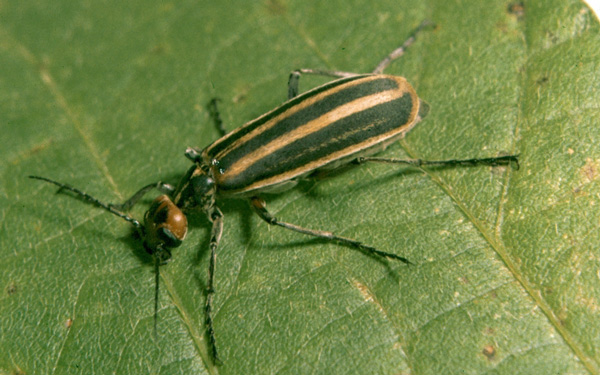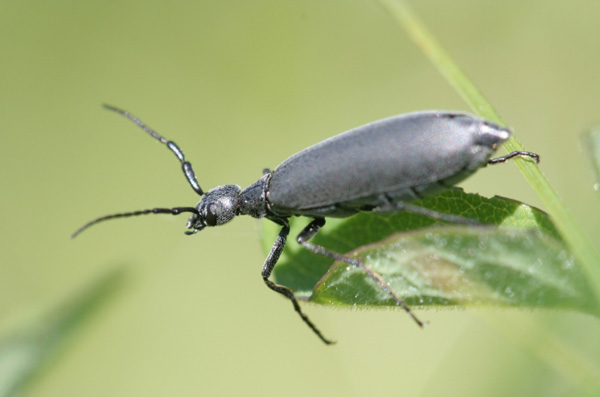
Blister beetles are members of a family of plant-feeding insects (Meloidae) that contain cantharidin, a toxic defensive chemical that protects them from predators. Accidentally crushing a beetle against the skin can result in a painful blister, the source of the insect’s common name.
Blister beetles have long (3/4″ to 1 1/4″) narrow bodies, broad heads and antennae that are about one-third the length of their entire bodies. The front wings are soft and flexible in contrast to the hard front wings of most beetles.
In sufficient quantity, the cantharidin in the bodies of living or dead blister beetles can be toxic, and in some cases lethal, to horses, sheep and cattle. The lethal dose is estimated to be between 0.5 and 1.0 mg of cantharidin per kilogram (2.2 pounds) of body weight. Cantharidin is very stable and remains toxic in dead beetles for a long time.
Animals can be poisoned by eating crushed beetles in cured hay. The severity of the reaction, ranging from temporary poisoning, to reduced digestive ability, to death, depends upon the amount of cantharidin ingested and the size and health of the animal.
Poisoning symptoms usually appear within hours and include irritation and inflammation of the digestive and urinary tract, colic and straining during frequent urination. This irritation may also result in secondary infection and bleeding. In addition, calcium levels in horses may be drastically lowered and heart muscle tissue can be damaged. Since animals can die within 72 hours, it is imperative to contact a veterinarian as soon as blister beetle poisoning is suspected.
Table 1. Estimated lethal numbers of blister beetles of two cantharidin
contents that must be ingested by horses of different weights.

Common Blister Beetle Species
Four species of blister beetles are relatively common throughout the eastern and central states: ashgray (Epicauta fabricii), black (E. pennsylvanica), margined (E. pestifera), and striped (E. vittata). There is variation in average cantharidin content among the species, but it has been consistently higher (about 5 mg/beetle) in the striped blister beetle than in the other species (about 0.5 mg/beetle). In addition to its high toxin content, striped blister beetles tend to congregate in large clusters along field margins rather than more spread out. This can result in harmful numbers of the beetles in baled hay.

Reducing the Potential for Blister Beetles in Hay
Tips For Hay Producers
- Learn to recognize blister beetles and understand their behavior. An effective preventive program will reduce the chances of a problem. There is no efficient way to inspect baled hay carefully enough to be sure that it is free of blister beetles.
- Blister beetles are not active when the first cutting is made in Kentucky; harvest at the late bud stage or when the first flowers open for high quality hay for horses.
- Blister beetles are attracted to blooms. Manage harvest intervals to minimize flowering of alfalfa or weeds in hay fields. Practice good broadleaf weed management.
- Check hay fields for blister beetles before cutting from July through early September. They prefer blooming plants and tend to cluster in masses near field edges. Avoid areas where beetles are present.
- Avoid crimping hay during harvest. Straddle cut swaths to avoid crushing beetles with tractor tires.
Tips For Horse Owners
Reduce the risk of feeding blister beetles to their horses by understanding some blister beetle basics and by taking the following precautions:
- If practical, possible grow your own alfalfa so that you can use proper preventive management practices.
- Buy from local sources. Develop a relationship your hay producer so that you know their production practices and hay quality.
- Buy first cutting hay. Blister beetles are not active then (in Kentucky).
While common, they have not been found in extremely high numbers in Kentucky. Historically, blister beetles have been most abundant in arid regions of the U.S. where grasshoppers are abundant most every year.
The adults feed on leaves in the tops of a plant, but are especially attracted to flowers where they feed on nectar and pollen. They gather in groups, so large numbers can occur in concentrated clusters in a field. These beetles are mid to late summer insects, active in mid-July and early August which translates to the third or fourth cutting.
Blister Beetle Biology
Female blister beetles lay clusters of eggs in the soil in late summer. The small, active larvae that hatch from these eggs crawl over the soil surface entering cracks in search for grasshopper egg pods which are deposited in the soil. After finding an egg mass, blister beetle larvae become immobile and spend the rest of their developmental time as legless grubs. They pupate during the following summer and emerge as adults. Blister beetle numbers increase dramatically following a dry summer with high grasshopper populations.
CAUTION! Please check with your local county agent or regulatory official before using any pesticide mentioned in this publication. Of course, ALWAYS READ AND FOLLOW LABEL DIRECTIONS FOR SAFE USE OF ANY PESTICIDE!
Images courtesy University of Kentucky Entomology except where noted


